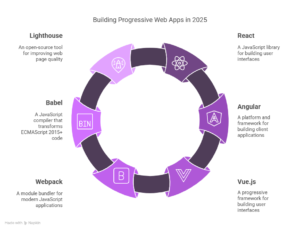In today’s fast-paced, tech-driven world, the phrase “embedded development software” might sound like something straight out of a science fiction movie, but it’s actually at the heart of many devices we use daily.
Embedded development software refers to specialized programs designed to manage and control the operation of embedded systems – these are small computer systems embedded within electronic devices to perform specific functions. From smartphones to automobiles, embedded systems play a crucial role in our daily lives.
According to a report by MarketsandMarkets, the global embedded systems market is expected to grow from $86.5 billion in 2021 to $116.2 billion by 2026, at a CAGR of 6.1% source link. This impressive growth highlights the increasing reliance on embedded systems
Need Tailored Software Solutions?
Our custom software development services cater to your specific business needs.
A Brief History of Embedded Development Software
Embedded systems have been around for decades, with their roots tracing back to the 1960s. The early days saw the use of basic microcontrollers that were hardwired to perform specific tasks. As technology advanced, so did the complexity of embedded systems. The development of more powerful processors and sophisticated software led to a surge in their applications, from household appliances to complex industrial machinery.
The Scope of Embedded Development Software
The scope of embedded development software is vast. It is utilized across multiple industries such as automotive, aerospace, healthcare, consumer electronics, and telecommunications. For instance, in the automotive industry, embedded systems manage everything from engine control to infotainment systems. In healthcare, they are crucial in devices like pacemakers and MRI machines, ensuring they operate efficiently and safely.
Key Features of Embedded Development Software
When it comes to embedded development software, certain features stand out:
- Real-time processing capabilities: Many embedded systems require the ability to process data in real-time, making speed and efficiency critical factors.
- Scalability and modularity: As the demands on systems increase, the software must be scalable and modular, allowing for easy updates and enhancements.
- Security features: Embedded systems often handle sensitive information or control critical functions, making robust security measures essential.
- Ease of integration with hardware: Seamless integration with the hardware components is crucial for the effective functioning of embedded systems.
Popular Programming Languages for Embedded Development
Programming languages play a vital role in embedded development. The most commonly used ones include:
- C and C++: These languages are popular due to their efficiency, low-level access to hardware, and portability.
- Python: While traditionally not a go-to for embedded systems, Python’s simplicity and the growing support for microcontrollers are making it increasingly popular.
- Assembly language: For tasks requiring highly optimized code and direct hardware manipulation, assembly language is a key choice.
- Java: Used in more complex embedded systems, especially those requiring robust network capabilities.
Development Tools for Embedded Software
Developing embedded software requires specialized tools. These include:
- Integrated Development Environments (IDEs): Tools like Eclipse and Visual Studio provide comprehensive environments for writing, testing, and debugging embedded software.
- Debugging tools: Effective debugging is critical, with tools such as JTAG debuggers and logic analyzers playing a pivotal role.
- Compilers and linkers: Converting code into a machine-readable format is a core aspect, handled by tools like GCC (GNU Compiler Collection).
- Simulators: These allow developers to test their software on virtual models of hardware before actual deployment.
Embedded Software Development Lifecycle
The development of embedded software typically follows a structured lifecycle:
- Requirement analysis: Understanding what the system needs to accomplish.
- Design and development: Writing the code and designing the system architecture.
- Testing and validation: Ensuring the software meets all requirements and functions accurately.
- Deployment and maintenance: Installing the software on the actual device and performing ongoing maintenance.
Challenges in Embedded Development
Despite its wide application, embedded development comes with its challenges:
- Limited hardware resources: Embedded systems often have restricted processing power, memory, and storage, making optimization crucial.
- Real-time constraints: Many systems must operate within strict time limits to function correctly.
- Security concerns: Protecting systems from cyber threats is a growing concern, especially as more devices connect to the internet.
- Portability issues: Software must often be adaptable to different hardware environments, adding complexity to development.
Best Practices for Embedded Development
To ensure success in embedded development, adhering to best practices is vital:
- Code optimization techniques: Writing efficient, resource-conserving code is essential given the limited resources.
- Use of version control systems: Tools like Git help manage changes and collaborate effectively.
- Importance of thorough testing: Rigorous testing ensures that the system performs as expected and can handle real-world scenarios.
- Regular updates and maintenance: Keeping the software up to date with the latest security patches and improvements is crucial.
Future Trends in Embedded Development
The future of embedded development looks promising with several emerging trends:
- Growth of IoT (Internet of Things): As more devices connect to the internet, the demand for sophisticated embedded systems will continue to grow.
- Use of AI in embedded systems: Artificial intelligence is increasingly being integrated into embedded systems for smarter decision-making and automation.
- The role of 5G technology: Faster communication speeds offered by 5G will enable more complex and real-time embedded applications.
- Increased focus on cybersecurity: As cyber threats evolve, embedded systems will need advanced security features to protect against vulnerabilities.
Embedded Development Software for tkxel
tkxel is a leading software development company known for its innovative solutions and expertise in embedded systems. They leverage cutting-edge embedded development software to create highly efficient and reliable products. tkxel’s approach focuses on customized solutions tailored to the specific needs of their clients, whether it’s in the automotive, healthcare, or consumer electronics sectors.
Case Studies of Embedded Development Success
- Automotive Industry: Embedded systems are used extensively in modern vehicles for functions like automatic braking and adaptive cruise control, enhancing both safety and user experience.
- Healthcare Device Innovation: Devices like pacemakers and insulin pumps rely on embedded software to monitor and respond to the body’s needs in real-time.
- Consumer Electronics: From smart TVs to home automation systems, embedded software ensures these devices are intuitive and responsive.
Benefits of Embedded Development Software
The advantages of using embedded development software are numerous:
- Efficiency and performance improvements: Embedded software optimizes the functionality of hardware, making devices more efficient.
- Cost reduction: Automated processes and efficient operation lead to lower production and operational costs.
- Enhanced functionality: Embedded systems provide sophisticated features, improving the overall capabilities of devices.
Choosing the Right Embedded Development Software
When selecting embedded development software, consider the following:
- Compatibility with hardware: Ensure the software is compatible with the device’s hardware components.
- Scalability: Choose software that can grow and adapt with evolving needs.
- Support and community: Rely on a strong support network and active community for valuable resources and help.
Conclusion
Embedded development software is a critical component in the modern technological landscape, driving innovation across industries. From enhancing everyday devices to enabling cutting-edge advancements in healthcare and automotive technologies, embedded systems are foundational to our increasingly digital world.
Companies are at the forefront of this evolution, leveraging their expertise to develop customized, efficient solutions that meet the unique needs of their clients. As technology continues to advance, the role of embedded development software will only grow, offering exciting opportunities for innovation and growth.





